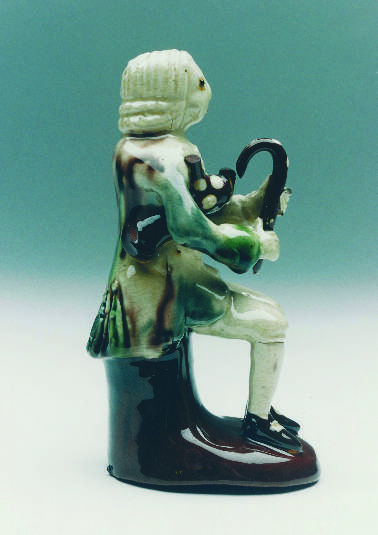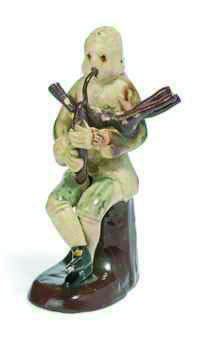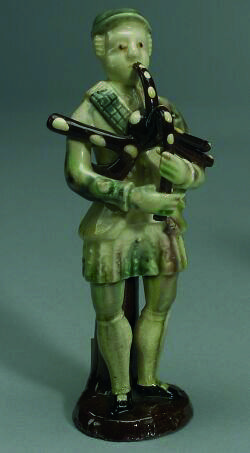The Bagpipe Society
The Bagpipers of John Astbury

I have recently been in correspondence with Jenny Coxon, dulcimer player and music researcher, in connection with my ongoing search for Hale the Piper. As a result of our correspondence, she very kindly offered me some photographs of a Staffordshire pottery figure which she had in her collection and were now surplus to her requirements. I was, of course, a grateful recipient and I am pleased to be able to include the photos in this edition of Chanter (rear cover and left). The original figurine is in the City of Stoke on Trent Museum and Art Gallery, reference no 141P1949. The figure is made from red and cream coloured earthenware, stained with coloured oxides and decorated with coloured slip under a clear lead glaze. It was made in Staffordshire sometime circa 1720-40 and is from the Miss M.D. Wood collection.
The piper has a rather benign expression and is seated, wearing a smart dress coat and playing a wonderful (if somewhat broken) spotty bagpipe. The blowpipe and drones are missing but, regardless, I rather like the little chap! I immediately recognised the figure from Roderick Cannon’s article, “Bagpipes in English Works of Art” which was originally published in the Galpin Society Journal in 1989 and more recently republished in the Bagpipe Society’s book “Essays on The Bagpipe in England”. On referring to Roderick’s article I noticed that the figure he depicted is slightly different from the one that I have photographs of. That got me searching the internet and I have found out a little more about the creator of the piper and others in his genre.

John Astbury, 1688 – 1743, was a pioneer of English potting technology and one of the earliest of the great Staffordshire potters. He allegedly learnt his craft by masquerading as an idiot whilst working for the renowned potting brothers, John Philip and David Elers, who had emigrated from Holland in 1688. He established his own factory in Shelton, in the Potteries, in the early 18th century. He became known for producing glazed red earthenware decorated with bits of white pipe clay (which he was the first to import from Devonshire); his mode of decorating with such appliqués is called sprigging. Thus, some of the earliest lead glazed Staffordshire figures have been attributed to him. John Astbury was also the first Staffordshire potter to use flint for improving the quality of the earthenware by making it whiter.

He produced a range of stoneware figures, including a number of bagpipers and other musicians. They are all of rather crude appearance and would have been modelled by hand after being cast in simple moulds.
In searching the internet for more information, I discovered a range of bagpipers made by Astbury and other potters working in the same period. I find them rather charming in their simplicity and to me, they are another indicator that the global statement that “bagpipes died out in England during the 17th century” rather questionable. Why else would Astbury, and others, mass produce bagpipers, if they were not still a popular and familiar feature in 18th century England? I am making some interesting discoveries about 18th century bagpipers - which you will no doubt read about in the future!
- Data Processing Notice (GDPR)
-
@BagpipeSociety on X (formally known as Twitter)
-
TheBagpipeSociety on Instagram
-
 BagpipeSociety on Facebook
BagpipeSociety on Facebook
Something wrong or missing from this page? Let us know!
